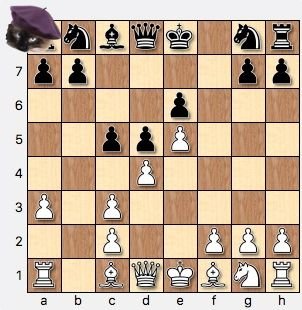
This is the second in a series of articles that provide a (hopefully) fun way to learn the history and strategy of specific chess openings as well as a memorization technique that I created.
More about my goals for this series you can see in Part 1, but basically this is intro type learning for fun and to promote chess in general, not a substitute for real studying.
So jumping right in, today we are looking at the French Defense. This is another very common defense agains the opening move of 1.e4 (1.e4 is the most common first move in chess). It is seen as a solid opening for black that repels attacks and builds a strong endgame for black, with plenty of opportunities for counterattack. It has some of the most complex lines in the game.
We will be looking at 5 of the main variations and discussing the ideas behind each.
History
"The French Defense has a proven reputation for adaptability and soundness and is attractive to the Black player who seeks a complex strategic fight in unbalanced positions, with healthy counterplay and many chances to decide sharp battles in his favor! Black's defensive resources are based on a sound strategic foundation, and White must be alert at all times and willing to play forcefully and incisively in order to try to prove his advantage in positions that he may choose against Black's sound Defenses.
Although analyzed by the Italian Lucena in the fifteenth century, the French Defense was named for the Parisian players who adopted the move 1…e6 in 1834 in the correspondence game against London." The opening was played by famous grandmasters like Mikhail Botvinnik, Tigran Petrosian, Viktor Korchnoi, and Nigel Short[1].
We'll be looking at the following variations. Here is a brief history of each, before we get into the strategy.
The Winawer
The most popular and interesting system in the French Defense. Really fun. A "battle of space vs. structure, bishops vs. Knights and initiative vs. material ensure a lively complex struggle. This variation, named after Szymon Winawer, a Polish player in the late 1800's, and pioneered by Nimzowitsch and Botvinnik, is one of the main systems in the French, due chiefly to the latter's efforts in the 1940s, becoming the most often seen rejoinder to 3.Nc3, though in the 1980s, the Classical Variation with 3...Nf6 began a revival, and has since become more popular."[2]

The Classical
The classical Variation is a large, old system has been mostly overshadowed by the Winawer Variation. However, many of the lines have been revisited, studied, and used more recently. Players like Victor Korchnoi, Nunn, Kortschnoj, Nigel Short and Jan Timman, for example have done much to energize certain lines with new ideas, and a number of systems in the Classical Variation can now be employed by ambitious second players looking for more than equality. [1]
The Rubenstein
Named for Akiba Rubenstein, a Polish grandmaster of the early 20th century, this is not a very popular opening, although seen occasionally. It frees up center play but is seen as usually a slight advantage for white.[2]

The Tarrasch
"Named after Siegbert Tarrasch", a german chess master and teacher of the early 20th century, "this move became particularly popular during the 1970s and early 1980s when Anatoly Karpov used it to great effect. Though less aggressive than the alternate 3.Nc3, it is still used by top-level players seeking a small, safe advantage."[2]
Often considered to be white's best response to the French defense, avoiding black's pin on Nc3.

The Advance
"The Advance Variation was frequently played in the early days of the French Defence. Aron Nimzowitsch believed it to be White's best choice and enriched its theory with many ideas. However, the Advance declined in popularity throughout most of the 20th century until it was revived in the 1980s by GM and prominent opening theoretician Evgeny Sveshnikov, who continues to be a leading expert in this line. In recent years, it has become nearly as popular as 3.Nd2; GM Alexander Grischuk has championed it successfully at the highest levels. It is also a popular choice at the club level due to the availability of a simple, straightforward plan involving attacking chances and extra space."[1]
The Exchange
"The Exchange Variation was recommended by Howard Staunton in the 19th century,[9] but has been in decline ever since. In the early 1990s Garry Kasparov briefly experimented with it before switching to 3.Nc3. Note that Black's game is made much easier as his queen's bishop has been liberated. It has the reputation of giving immediate equality to Black, due to the symmetrical pawn structure."[2]
This is like the "ah f*** it" variation. The French can be hard to play against, so if you want to lose a bit of initiative as white, you can just open up the middle of the board and hope for the best. Many of these games can end in early draw.
Ideas behind the French Defense
1.e4 e6

2.d4 d5

The game starts 1.e4 e6, and continues 2.d4 d5. White is making a claim to the center, and Black quickly challenges the pawn on e4.
"The French Defense is an opening, which most players either love or hate. With the very first move, Black tells the Bishop at c8 that it is going to be a long time before that piece will play a active role in the game, at least on the kingside. White will be granted an advantage in the center and an advantage in space."[1] However, patient players can build a strong defense and over time let white back itself into a corner.
White's options include defending the e4 pawn with 3.Nc3 or 3.Nd2, exchanging with 3.exd5, or advancing the pawn with 3.e5, each of which lead to the variations we'll discuss.
The Winawer
The Winawer goes a little something like this:
1.e4 e64
2.d4 d5
3.Nc3 Bb4

White protects the e pawn with the knight, then black pins the night to the king with the bishop.
4.e5 c5

White advances the pawn, that is no longer protected because of the pin, forward out of harms way. Black attacks the d pawn with it's c pawn. Now, white could have taken the c pawn with it's dpawn, but then it's center would have been destabilized. So instead of taking that, white attacks the bishop with the a pawn.
5.a3 Bxc3+

Bishop goes ahead and takes the knight, then white takes back the bishop with the b pawn.
6.bxc3

So what are we left with? Black has stronger pawn structure potential, while white has a spacial advantage on the kingside. White has doubled pawns, which black can exploit, but white can also use for extra protection on the center. So it leads to an interesting, unbalanced game. This is the preferred variation of most players of the French.
Memorization Technique
If you don't want to go back to my first post, https://steemit.com/chess/@cryptastic/chess-class-1-explanation-of-the-sicilian-dragon-plus-my-memorization-technique, here's a quick refresher of the system.
The idea is to use people's names(male for white, female for black) and food for the opening moves along with horse and bishop imagery. The names are either one, two, or three syllables, depending on if they are moved 1, 2, or, 3 ranks. For example, white's first move is two ranks to e4, therefore the name is Eddie, two syllables. Black's first move is e6, one rank, therefore the name is Eve, one syllable.
1.e4 e6
2.d4 d5
3 Nc3 Bb4
4.e5 c5
5.a3 Bxc3
6.bxc3
The mnemonic story is:
Eddie and Eve ate danishes and donuts on a cold night with a bad bishop named Elliot. Carol and Al told the bishop to take his horse, but Bill stopped the bishop.
Broken down:
Eddie and Eve - e4 and e6
ate danishes and donuts - d4 and d5
on a c(c file)old night - knight to c3
with a bad bishop- bishop moves to b4
named Elliot(3 syllables) - e6 (pawn to 3rd rank from starting position)
Carol and Al - c5 and a3
told the bishop to take his horse - bishop takes knight
but Bill stopped the bishop - b pawn takes the bishop
That's the Winawer!
The Classical
In the classical lines, black takes a more traditional approach to control the center, leading to more balanced play than the Winawer, not giving so much space for white to attack on the kingside.
The moves are the same as the Winawer up to 3.Nc3, but then black just makes a move claiming center space with 3 ...Nf6. The moves are usually followed by either 4.Bg5 or 4.e5, attacking black's night on f6.

Memorizing The Classical
The story is just a simpler version of the Winawer, just a bit different.
- e4 e6
- d4 d6
- Nc3 Nf6
Eddie and Eve ate danishes and donuts on a cold night, it was Friday night.
Simple.
The Rubenstein
Begins with the normal French starting moves 1.e4 e6, 2.d4 d5, then Nd2(avoids the possible pin by the bishop) dxe4. Finally the Nd2 takes back the e pawn.


"White has freer development and more space in the centre, which Black intends to neutralise by playing ...c7–c5 at some point. This solid line has undergone a modest revival, featuring in many GM games as a drawing weapon but theory still gives White a slight edge. After 3... dxe4 4. Nxe4, Black has the following options:
The most popular line is: 4...Nd7 5.Nf3 Ngf6 6.Nxf6+ Nxf6 when Black is ready for ...c5.
4...Bd7 5.Nf3 Bc6 (the Fort Knox Variation) activating the light-square bishop, which is often played by Alexander Rustemov."[2]
Memorizing the Rubenstein
1.e4 e6
2.d4 d5
3.Nd2 dxe4
4.Nxe4
The story is:
Eddie and Eve ate danishes and donuts on a dark night. Debra picked up Eddie on her horse.
Another simple one, right?

hmm Rocket disagrees
The Tarrasch
This is similar to the classical for black, opting to go for the center instead of the unbalance Winawer. However, unlike the classical, this is more forced on black by white playing 3. Nd2. For the Winawer black should pin the knight on c3, but if white plays Nd2 it doesn't work.

However, black can also play 3 ...c6 attacking the center, or even 3 ...be7, a waiting move.
Memorizing the Tarrasch
Eddie and Eve danishes and donuts on a dark night. It was a Friday night. (3 ...Nf6)
or
Eddie and Eve ate danishes and donuts on a dark night with Carol.(3 ...c6)
The Advance Variation
The Advance Variation presents black with many attacking opportunities, especially on the queenside. It can be very dangerous for white.
After the usual first moves of the French 1.e4 e6 1.d4 d5, white advances the e4 pawn to e5.


With c5, black immediately starts to weaken white's pawn structure. White defends the d pawn with c2. The game continues with attack and defense of the d4 square by the knights. So far we have:
1.e4 e6
2.d4 d5
3.e5 c5
4.c2 Nc6
5.Nf3

Often is followed by 5 ...Qb6, which adds pressure to the d4 pawn, trying to break white's pawn chain, or 5 ...bd7, which is a waiting move. It is usually played later in the game so the theory is that by playing it early, it gives white an opportunity to play a committing move that black can interpret and set up his defense more accurately, especially looking to see if white will play 6.a3, which is a wasted move if white's queen is not on b6.[2] See below.

Qb6

Bd7
Memorizing the Advance
The story here is:
Eddie and Eve ate danishes and donuts with Elliot and Carol. Cate brought her horse on Friday night.
1.e4 e6 - eddie and eve
2.d4 d5 - danishes and donuts
3.e5 c5 - elliot and carol
4.c2 Nc6 - cate and her horse
5.Nf3 - friday night
On to the exchange!
The Exchange Variation
The exchange variation is often seen as leading to somewhat boring games, often ending in draws; a way for white to avoid some of the sharp, aggressive lines we've looked at. It's symmetrical play between black and white. There are opportunities for black to break the balance and make more interesting games, for example trying to castle on opposite sides.
1.e4 e6
2.d4 d5
3.exd5 exd5

The game can continue symmetrically, as with 4.Bd3 Bd6 5.Nf3 Nf6 6.0-0 0-0, or white or black can try to unbalance the game by attacking the other's d pawn with their c pawn, or as mentioning before, trying to castle on the opposite side from their opponent.
Basically, the exchange is a way that white can try to play symmetrically for a drawish position, and one or the other players has to make an effort to mix things up if they want to play aggressively.
Memorizing the Exchange
This is a simple one:
Eddie and Eve ate danishes and donuts, Eddie ate the danishes, and Eve ate the donuts. Dull bishops rode horses.
Dull bishops rode horses means that really you can play any combination knights and bishops you feel like and be fine. Bd3, Nf3, Nc3 for white, or Bd6, Nc6, or Nf6 for black
In Summary
Here are the variations we looked at roughly in order of popularity:
The Winawer - leads to exciting games
The Tarrasch - center battle, typically small advantage for white
The Classical - center battle
The Advance - center battle
The Rubenstein - can be great for black but risky, white has advantage
The Exchange - The easy way out of the French if you don't feel like learning the above theory

Phew, I'm tired. That was a long post. Once again it's all in fun for casual players just to get you started; hoped you enjoyed it.
I encourage you again to check out my part 1, link below, and look for more in the future! Any recommendations of openings you'd like to see are welcome.
Sources
- St.Emilion Chess Club
- T.D. Harding, French: MacCutcheon [sic] and Advance Lines, Batsford, 1979, pp. 12, 56. ISBN 0-7134-2026-X.
- https://en.wikipedia.org/wiki/French_Defence#cite_ref-4

steemians like you on steemit. Just so know... deep down, I believe you will do great things. This is only the beginning, I believe in you!Great post @cryptastic! Loving it all. Nice to have
We can be best buddies. Good news, I shared your post and followed you, follow me back to share the excitement!
Have fun!
Hey, thanks for the encouragement. Sounds good!
Nice post regarding the French! I am a Sicilian type of player myself :D
Thanks! The first of this series was about the sicilian dragon, you should check it out :-)
I definitely will, thank you! :)
Your post was mentioned in my hit parade in the following category:Congratulations @cryptastic!
I didnt know that
Thank you for the post. I have used the French in literally hundreds of tournament games.
Glad you liked it, what's your favorite variation?